Will it be impossible for travelers to visit local Japan in 10 years? (4)
Table of Contents
1: Correlation between accessible railway stations and the number of overnight stays
2: Making accessible railway stations after increasing the number of travelers
3: Reasons why foreign travelers do not travel to local areas
4: Positive impacts of using regional railways by foreign travelers
1: Correlation between accessible railway stations and the number of overnight stays
There is a high correlation between the rate of steps eliminated at railway stations and rail travel. In prefectures where the rate of steps eliminated at railway stations is low, the share of rail travel is also low. In contrast, the share of rail travel is high when the rate of steps eliminated at railway stations is high.
There is also a relationship whereby the share of overnight stays (the share of overnight visitors traveling for tourism purposes by prefecture, 2019) is lower when the rate of steps eliminated at railway stations is low.
Rate of steps eliminated at stations by prefecture and share of the number of overnight stays by prefecture
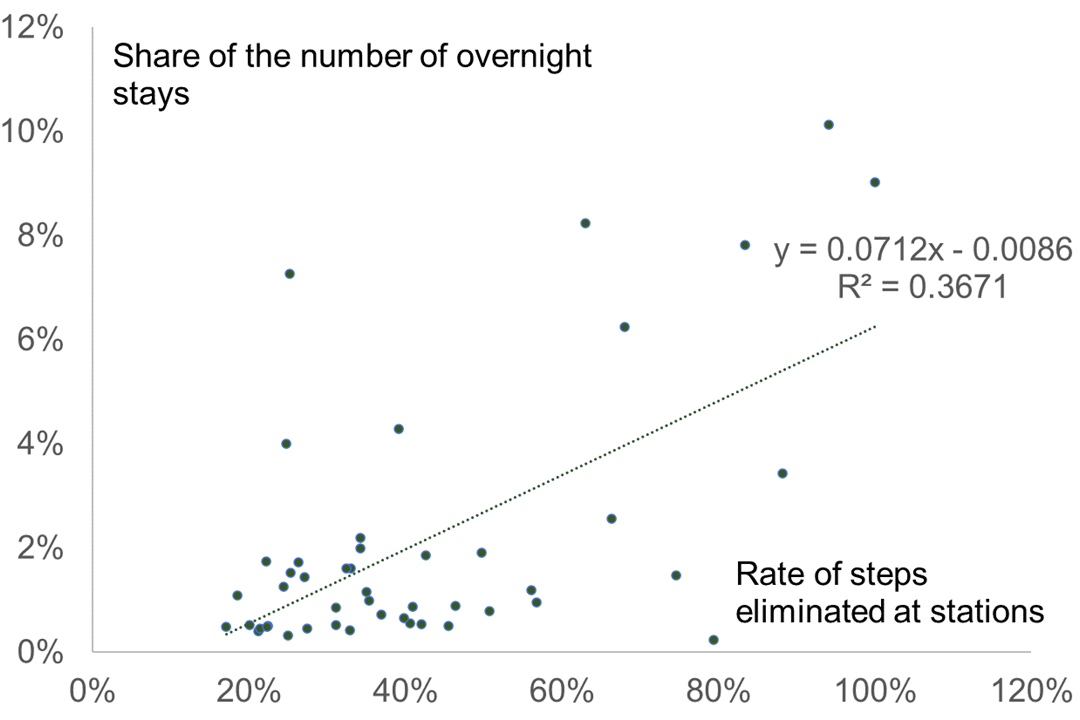
SOURCE: Ministry of Land, Infrastructure, Transport and Tourism, Japan Tourism Agency
Of course, these are ‘chicken and egg’ relationships. We can expect a virtuous circle: more travelers by rail (i.e., more revenue) means more investment in closing the steps at railway stations, and more convenience means even more travelers by rail. In addition, if the number of overnight stays of travelers increases, the amount of money spent on tourism will also increase, which will allow investment in eliminating steps at railway stations. The reverse is also true.
Therefore, it is essential to increase the number of rail travelers first.
In the case of a low rate of step reduction at railway stations, the formula (y = 0.0712X-0.0086) derived from the share of overnight stays shows that a 1% improvement in the rate of step reduction at railway stations would result in a 0.0626% improvement in the share of overnight stays. This impact translates into an increase in overnight stays of 195,000 people. If each guest spends 28,889 yen (average Japanese travel budget of 53,444 yen divided by the average number of overnight stays of 1.85 nights, 2019), a 1% improvement in the rate of step reduction at railway stations would have an economic impact of Yen 5.65 billion.
2: Making accessible railway stations after increasing the number of travelers
How can they increase the number of rail travelers while the rate of steps eliminated at railway stations needs to be higher due to the lack of budget and other unfavorable circumstances? They need to take measures to encourage travelers to come even if there are steps at railway stations. In addition to the fact that the Japanese people are facing a declining population and can travel by private car, etc., measures are needed, especially for foreign visitors who use the railways. In fact, in 2019, the most popular means of transport used during their stay in Japan were railways and monorails (69.9%) and suburban buses (24.5%) in first and second place, respectively. Railways and buses are the most used modes of transport for foreign visitors.
Transport used by foreign visitors during their stay in Japan (multiple responses, %)
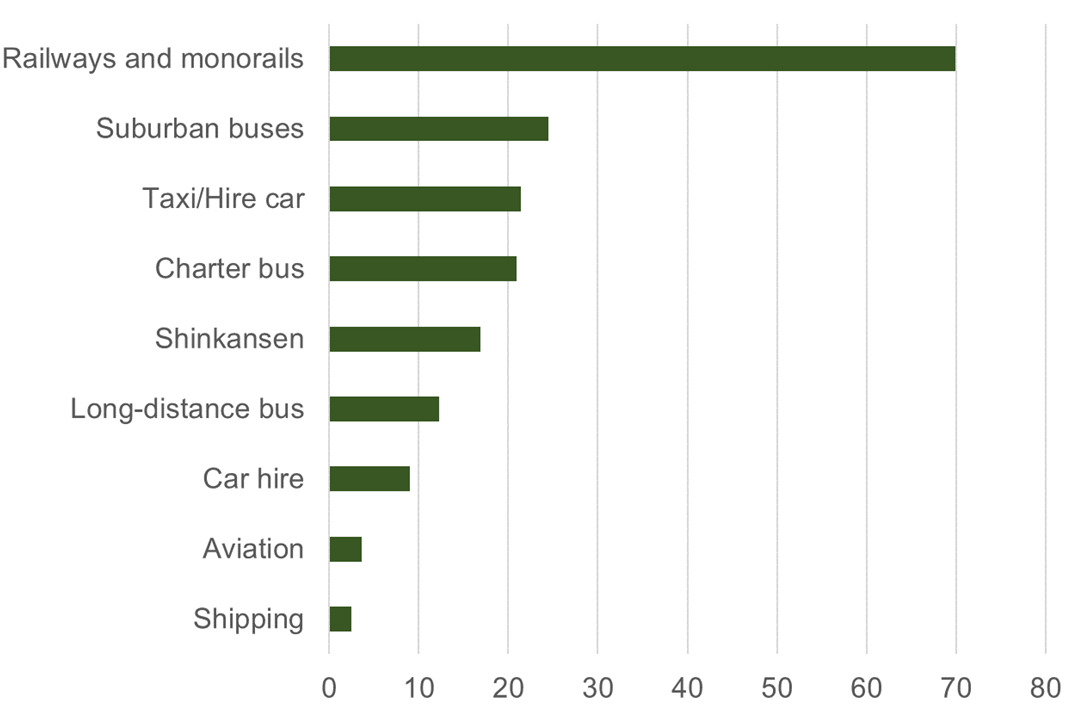
SOURCE: Japan Tourism Agency
The average number of overnight stays for a foreign visitor to Japan is 6.2 nights, 2.4 times the average Japanese domestic trip. Naturally, this makes their luggage larger and heavier. Large, heavy luggage is significantly more difficult to carry when there are steps in railway stations. Therefore, luggage reduction is essential.
To attract foreign visitors to the countryside, the Japan Tourism Agency is promoting “Hands-Free Travel,” where foreign visitors to Japan can use Japanese courier services and sightsee without having to carry luggage.
However, it is more critical that foreign visitors can come without having to carry luggage within Japan and to and from their homes to Japan. We can create such convenience by renting clothes for them.
According to a JTB survey of Japanese people, the most challenging part of preparing for an overseas trip is preparing luggage (22%). The most troublesome part of returning from a trip is putting away luggage (48%). Carrying baggage is not only troubling for travelers.
The CO2 reduction effect of not carrying 20 kg of checked baggage (round trip to Narita Airport) is equivalent to 186 plantations, 11 days of CO2 emissions per person, or an overwhelming 179 days of CO2 emissions per person if the reduction is limited to the daily life sector. This emission is an overwhelming reduction in CO2 emissions per person of 11 days, or 179 days if limited to the living sector. This emission is 21 times more effective than installing solar panels and 58 times more effective than installing electric vehicles (rechargeable energy) in terms of CO2 reduction per day.

Sources: ICAO, ECTA, Ministry of the Environment, Government of Japan
This sustainable travel is also what global travelers want: 75% of international travelers surveyed by Booking.com said they would like to use more environmentally friendly modes of transport (such as walking, cycling, and public transport rather than taxis and rental cars). In addition, 41% of global travelers want to contribute to reducing their impact on climate change, and 33% want to take action to reduce CO2 emissions from transport.
Suppose international visitors to Japan use courier services to deliver their luggage after arrival in Japan. In that case, CO2 emissions will increase by the amount of luggage transported by freight trucks, which goes against sustainable travel.
3: Reasons why foreign travelers do not travel to regional areas
Foreign visitors rarely travel to rural areas: in 2019, only five prefectures – Osaka (43.4%), Tokyo (42.4%), Kyoto (32.8%), Chiba (32.3%) and Nara (14.3%) – had a visit rate of more than 10% of foreign visitors. Conversely, there are 19 prefectures with visitation rates below 1%, including Kochi, Fukui, and Shimane. Thus, prefectures visited by foreign tourists are unevenly weighted. As of 2019, regional railways and bus operators could not get a positive contribution.
Visitation rates of foreign visitors to Japan by prefecture (2019)
1 Osaka Prefecture 43.41% 2 Tokyo Metropolitan 42.37% 3 Kyoto Prefecture 32.83% 4 Chiba Prefecture 32.29% 5 Nara Prefecture 14.30% 6 Hokkaido 9.67% 7 Aichi Prefecture 9.28% 8 Fukuoka Prefecture 9.01% 9 Okinawa Prefecture 7.53% 10 Kanagawa Prefecture 6.57% 11 Yamanashi Prefecture 6.55% 12 Hyogo Prefecture 6.38% 13 Shizuoka Prefecture 5.22% 14 Oita Prefecture 3.95% 15 Gifu Prefecture 3.59% 16 Nagano Prefecture 3.17% 17 Hiroshima Prefecture 3.03% 18 Ishikawa Prefecture 2.31% 19 Kumamoto Prefecture 2.16% 20 Nagasaki Prefecture 1.60% 21 Toyama Prefecture 1.34% 22 Kagoshima Prefecture 1.20% 23 Wakayama Prefecture 1.19% 24 Kagawa Prefecture 1.16% 25 Okayama Prefecture 1.11% 26 Tochigi Prefecture 1.10% 27 Saga Prefecture 1.09% 28 Miyagi Prefecture 1.02% 29 Aomori Prefecture 0.83% 30 Mie Prefecture 0.69% 31 Saitama Prefecture 0.64% 32 Shiga Prefecture 0.63% 33 Miyazaki Prefecture 0.60% 34 Yamaguchi Prefecture 0.57% 35 Niigata Prefecture 0.57% 36 Ibaraki Prefecture 0.54% 37 Tottori Prefecture 0.48% 38 Iwate Prefecture 0.47% 39 Yamagata Prefecture 0.42% 40 Gunma Prefecture 0.39% 41 Akita Prefecture 0.38% 42 Ehime Prefecture 0.37% 43 Tokushima Prefecture 0.30% 44 Fukushima Prefecture 0.25% 45 Shimane Prefecture 0.24% 46 Fukui Prefecture 0.19% 47 Kochi Prefecture 0.19%
SOURCE: Japan Tourism Agency
We can see the visitation rate of foreign visitors tends to rise when the rate of steps eliminated at stations exceeds 50% by the relationship between the visitation rate by prefecture and the rate of steps eliminated at stations. However, some prefectures, such as Saitama Prefecture, have a visitation rate of only 0.6%, even though the rate of steps eliminated at stations is as high as 79%. This reason may be due to the need for more tourism resources in Saitama Prefecture or possibly foreigners confusing Saitama Prefecture with Tokyo.
Rate of steps eliminated at train stations and visitation rate of foreigners by prefectures
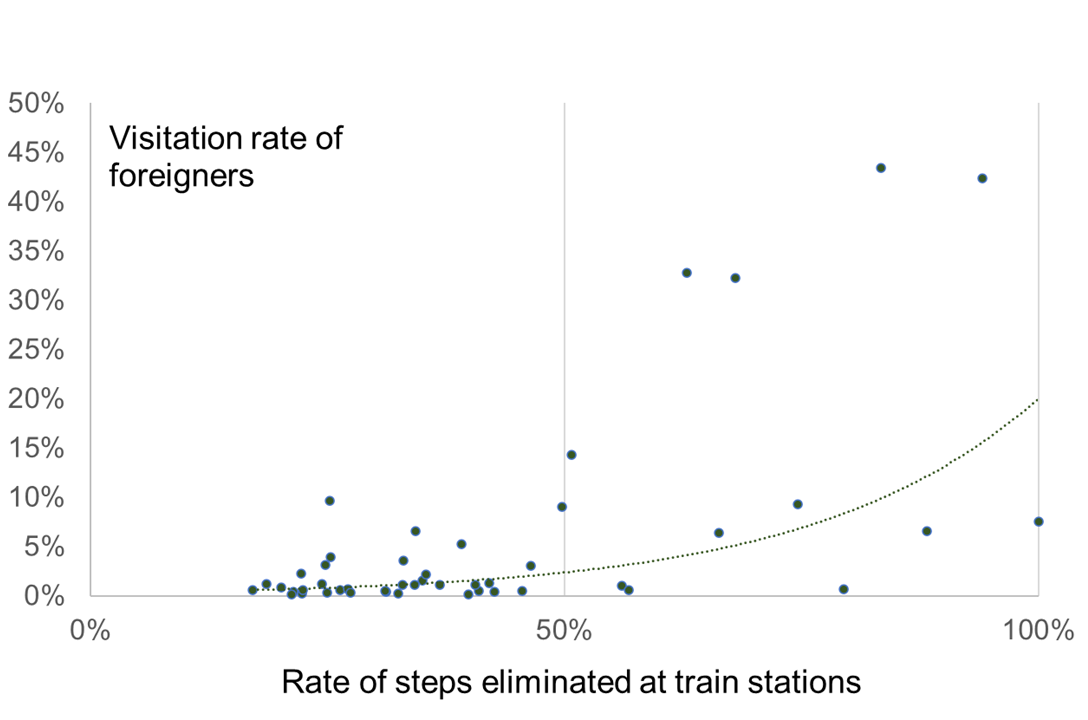
SOURCE: Ministry of Land, Infrastructure, Transport and Tourism, Japan Tourism Agency
In addition to the existence of steps at train stations, foreign visitors do not travel to rural areas because of the need for more information about rural areas.
According to the Japan Tourism Agency’s 2019 Questionnaire on the Improvement of the Reception Environment for Foreign Visitors in Japan, the most common problems during travel in Japan(multiple answers) were: ‘Lack of rubbish bins’ (23.4%), followed by ‘Inability to communicate with staff at facilities’ (17.0%), ‘Use of public transport’ (12.2%), ‘Lack of multilingual displays and difficulty in understanding (tourist information boards, maps, etc.)’ (11.1%) and ‘Free public wireless LAN access’ (11.0%).
The most common problems during travel in Japan(multiple answers)
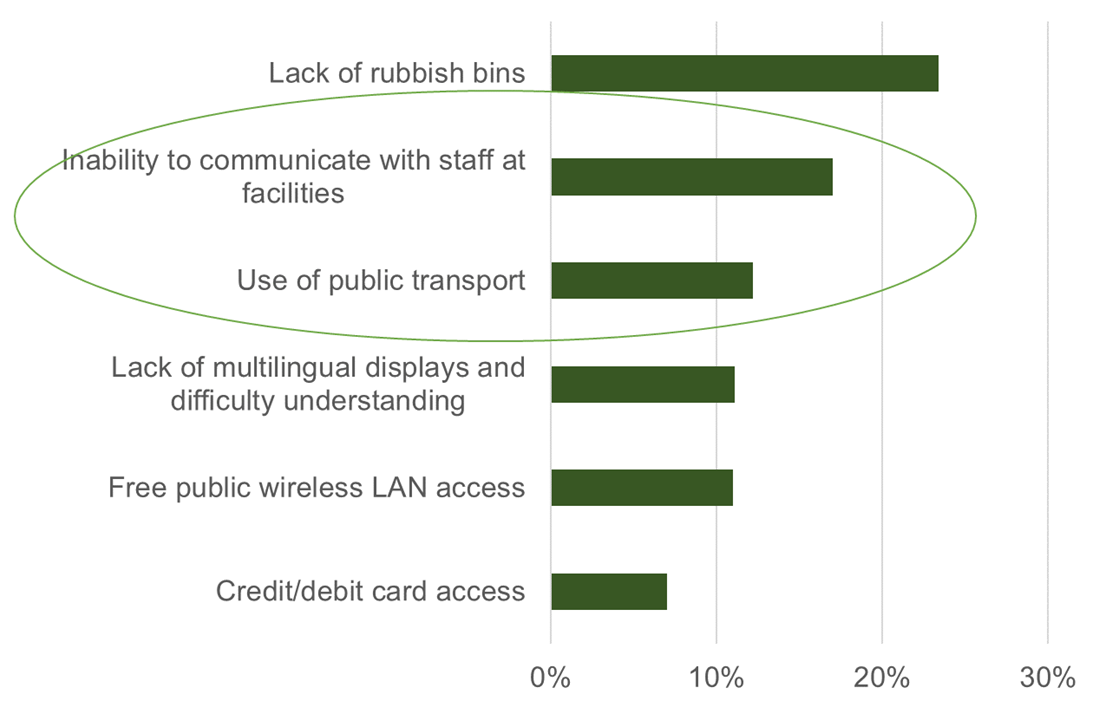
SOURCE: Japan Tourism Agency
In particular, the first and second most troubled transport operators in terms of ‘local public transport use’ are ‘buses’ (51% and 50% respectively) and ‘railways other than Shinkansen’ (50%), significantly higher than the third-placed ‘Shinkansen’ (21%) and the fourth-placed ‘taxis’ (8%). These ‘railways other than Shinkansen’ and ‘buses’ are regional railway operators and passenger buses in serious financial difficulties. The proportion of respondents who have visited both urban and rural areas by public transport and found them ‘convenient’ is high in urban areas (86%) and deficient in rural areas (8%).
The most troubled transport operators in terms of ‘local public transport use’
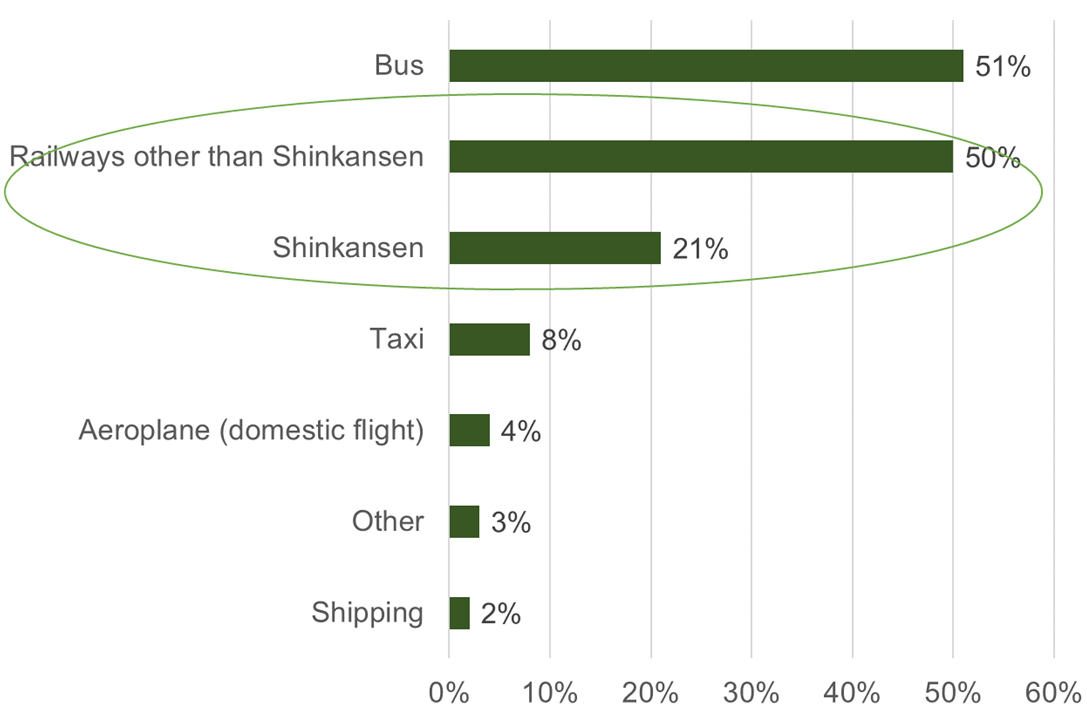
SOURCE: Japan Tourism Agency
In addition, the proportion of respondents who answered ‘convenient’ for ‘not being able to communicate with staff at facilities’ is lower in rural areas, at 52%, compared to 87% in urban areas. Furthermore, the percentage of respondents who answered ‘convenient’ is also lower for ‘multilingual displays,’ at 56% in rural areas compared to 87% in urban areas.
Perceived convenience (Foreigners visited both urban and rural areas)
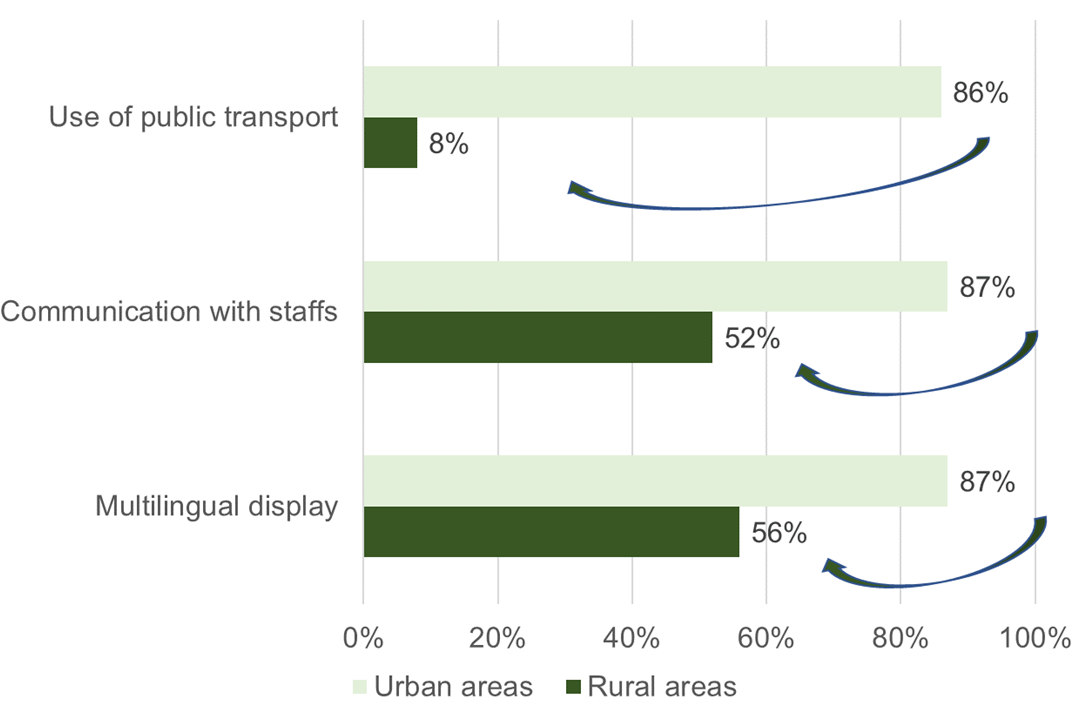
SOURCE: Japan Tourism Agency
Thus, we can understand that foreign travelers are anxious and dissatisfied with regional tourism regarding soft aspects, such as how to use public transport, communication, and multilingual displays. Therefore, they are reluctant to visit the regions.
Therefore, our company aims to promote regional tourism among foreign travelers through clothing rental and a pre-trip concierge service.
4: Positive impacts of using regional railways by foreign travelers
The number of foreign visitors to Japan in 2019 was 31.88 million. As the 95 regional railway operators had 479.08 million annual passengers (2019), we can calculate that just one round-trip ride by a foreign visitor to any regional railway in Japan boosts the number of regional railway passengers by 13%. Suppose the regional railway operators in the neighborhood work together to increase foreign visitors to take multiple rides on each regional railway. In that case, we can expect that this will have a significant demand-boosting effect.
In this way, it is necessary to take measures to use foreign visitors to Japan as a catalyst for a recovery in demand for regional railways and buses. We would be happy if our services could contribute to this.

